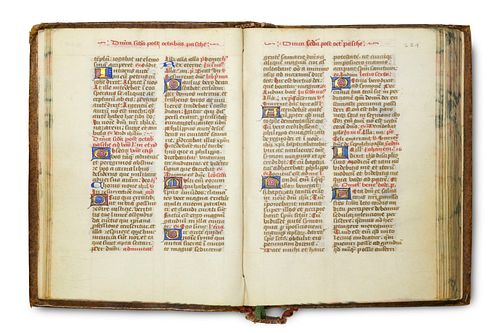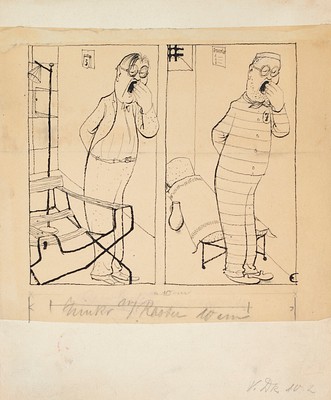Stundenbuch. M.S. Heures en Velin Miniat. 716. (Rückentitel). Mit über 1100 goldgehöhten roten und blauen Initialen, sowie roten und blauen Lombarden
Two ways to bid:
- Leave a max absentee bid and the platform will bid on your behalf up to your maximum bid during the live auction.
- Bid live during the auction and your bids will be submitted real-time to the auctioneer.
Bid Increments
| Price | Bid Increment |
|---|---|
| EUR€0 | EUR€10 |
| EUR€100 | EUR€10 |
| EUR€200 | EUR€20 |
| EUR€300 | EUR€30 |
| EUR€420 | EUR€30 |
| EUR€480 | EUR€20 |
| EUR€500 | EUR€50 |
| EUR€2,000 | EUR€200 |
| EUR€3,200 | EUR€300 |
About Auction
Dec 14, 2021
Jeschke Jádi Auctions Berlin GmbH info@jvv-berlin.de
- Lot Description
Stundenbücher
Stundenbuch. M.S. Heures en Velin Miniat. 716. (Rückentitel). Mit über 1100 goldgehöhten roten und blauen Initialen, sowie roten und blauen Lombarden teils mit Fleuronée. 162 Bll. (Handschriftliche Paginierung fehlerhaft), unvollständig. Blattgröße ca. 15,4 x 11,5 cm. Schriftspiegel ca. 11,2 x 7,6 cm. Lateinische Handschrift auf Pergament. Textura, geschrieben in schwarzbrauner Tinte. Zwei Kolumnen. 34 Zeilen. Wohl Frankreich zweite Hälfte des 15. Jahrhunderts. Buchschnitt marmoriert. Ldr. d. 18 Jh. (berieben und beschabt).
Das vorliegende großformatige Stundenbuch-Manuskript ist typologisch aufgebaut im Rythmus von Invitatorium, Hymnus, Psalm, Responsorium, Canticum, Gebeten und Lesungen. Es beginnt mit dem Ostertriduum der liturgischen Feier der Osternacht, mit den Vigilien und den Horen (officium lectionis), Hymnen, Psalmen und Lesungen aus der Bibel. Gefolgt von der Feier des Karsamstags, dem zweiten Tag des österlichen Triduums und der Ostersonntagliturgie. Christi Himmelfahrt am 39. Tag nach Ostersonntag wird mit der Vigilia Ascensionis domini gefeiert. Fol. 232 f. Den Abschluss bildet Pfingsten mit der Pfingstvigil (Sabbato in vigilia penthecostes) am 49. Tag nach Ostersonntag Fol. 239r f. mit der Aussendung des Heiligen Geistes (In die sancte trinitatus) Fol. 247r f.. Später folgt die Conceptio virginis Mariae (Maria Empfängnis), welche am 9. Dezember gefeiert wird 259 f. Interessant ist auch der Einbezug der Kathedra Petri, jenes sowohl Elemente des Totengedächtnisses als auch der Würdigung der "Schlüsselgewalt" des heiligen Petrus enthaltendes Fest, das an den Amtsantritt des Heiligen als ersten Inhaber des Heiligen Stuhls erinnern soll. Fol. 309 f. Zitiert werden weiterhin die Heiligen Lucia Fol. 263 f. Agnes Fol. 290 f., Vinzenz Fol. 293v f. Polykarp 299r f., sowie Blasius Fol. 310r f. und Agathe, Ambrosius Fol. 319f., Georg Fol. 320, die Apostel Phillipus und Jakobus Fol. 327r f.. Als Äbte werden Johannes Fol. 299v und Benedikt Fol. 315r genannt. Regional das Stundenbuch verortend, das aufgrund von stilistischen und liturgischen Merkmalen mit großer Wahrscheinlichkeit dem französischen Sprachraum zuzuordnen ist, wäre möglicherweise die Behandlung des Heiligen Gangolf Fol. 333f.. Er ist Namensgeber der Orte Saint-Gingolph (Haute-Savoie) und Saint-Gengoulph im Département Aisne. Am Ende mit der Suffragia Sanctorum, der Anrufung der Heiligen im Gebete Fol. 379f. und dem Ordo Librorum Fol. 388v. Formal interessant ist der Wechsel der Textura ab Folio 339 in eine dichtere Lineatur, wodurch eine Händescheidung anzunehmen ist. - Seiten nur selten etwas fleckig, bzw. wellig. Die teils springende Kollation der von späterer Hand in Tinte auf das Pergament aufgetragenen Blattzählung lassen vermuten, dass sämtliche Miniaturen und der erste größere Teil Textseiten fehlt. Insgesamt schönes großformatiges Manuskript.
Book of Hours.With over 1100 gold heightened red and blue initials, and red and blue lombards partly with fleuronée. 162 ll. (Handwritten pagination incorrect), incomplete. Sheet size ca. 15,4 x 11,5 cm. Type area ca. 11,2 x 7,6 cm. Latin manuscript on parchment. Textura written in black-brown ink. Two columns. 34 lines. Probably France second half of the 15th century. Marbled edges. Leather of the 18th cent. (rubbed and scuffed). The present large-format Book of Hours manuscript is typologically structured in the rhythm of invitatory, hymn, psalm, responsory, canticle, prayers and readings. It begins with the Easter Triduum of the liturgical celebration of the Easter Vigil with the Vigils and the Horen (officium lectionis), hymns, psalms and readings from the Bible. Followed by the celebration of Holy Saturday the second day of the Paschal Triduum and the Easter Sunday liturgy. Ascension of Christ on the 39th day after Easter Sunday is celebrated with the Virgilia Ascensionis domini. Fol.. 232 f. Pentecost concludes with the Pentecost Virgil (Sabbato in vigilia penthecostes) on the 49th day after Easter Sunday Fol. 239r f. with the sending forth of the Holy Spirit (In die sancte trinitatus) Fol. 247r f.. Later follows the Conceptio virginis Mariae (Conception of Mary), which is celebrated on December 9 259 f. Interesting is also the inclusion of the Cathedra of Peter, that feast containing both elements of remembrance of the dead and appreciation of the "key power" of St. Peter, which is to commemorate the saint's assumption of office as the first holder of the Holy See. Fol. 309 f. Further cited are St. Lucia Fol. 263 f. Agnes Fol. 290 f., Vincent Fol. 293v f. Polycarp 299r f., as well as Blasius Fol. 310r f. and Agathe, Ambrose fol. 319f., George fol. 320, the apostles Phillipus and James fol. 327r f. John fol. 299v and Benedict fol. 315r are named as abbots. Regionally locating the Book of Hours, which due to stylistic and liturgical features is most likely to be assigned to the French-speaking area, would possibly be the treatment of Saint Gangolf Folio 333f.. He is the namesake of the towns of Saint-Gingolph (Haute-Savoie) and Saint-Gengoulph in the department of Aisne. At the end with the Suffragia Sanctorum, the invocation of the saints in prayer fol. 379 f. and the Ordo Librorum fol. 388v. Formally interesting is the change of textura from folio 339 into a denser ruler, whereby a separation of hands can be assumed. - Pages only rarely somewhat stained, or wavy. The partly jumping collation of the sheet counting applied by a later hand in ink on the parchment suggest that all miniatures and the first larger part of text pages are missing. Overall, a beautiful large-format manuscript. *
- Buyer's Premium



 EUR
EUR CAD
CAD AUD
AUD GBP
GBP MXN
MXN HKD
HKD CNY
CNY MYR
MYR SEK
SEK SGD
SGD CHF
CHF THB
THB













